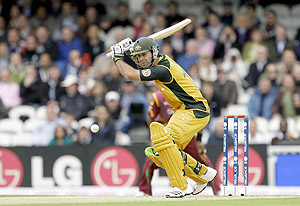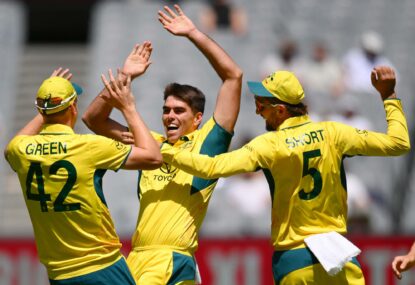
Australia captain Ricky Ponting swings out at the ball. AP Photo/Matt Dunham
All things come to those who wait, and it seems that Australian cricket is being rewarded with the maturing of Ricky Ponting as a captain of the national cricket side, one of the most iconic and difficult jobs open to an Australian.
Ling time readers of The Roar will know that I’ve expressed the view many times that Ponting is the best Australian batsman since Don Bradman.
And one of the worst captains.
There is no need here to relive the mistakes, tactical and cultural, that Ponting has been involved with as captain. This season, though, he seems to have matured on and off the field.
He has taken a relatively inexperienced bowling attack, and with some astute captaincy, has contrived to get 20 wickets a Test out of his bowlers time and time again. The mentoring role involved in this exercise has forced him to think more about his responsibilities for setting the style of the team.
At Hamilton, for instance, in the just finished Test there, Ross Taylor absolutely monstered Nathan Hauritz in the first innings, taking 25 from him in one over.
In the second New Zealand innings, Ponting held Hauritz back until Taylor was dismissed. Michael Clarke did the spinning, and did it well, until Hauritz’s nemesis was out of the way.
Off the field, too, Ponting won plenty of plaudits from the New Zealand officials for his supportive manner in performing his duties as the team’s captain. He was invariably pleasant and co-operative, and when he expressed an opinion, it was positive and helpful.
This positive and helpful attitude stretches to his views on the future of the game. Cricket lovers around the world will applaud his forthright statement that he is against day-night Tests with pink balls.
Cricket administrators are in danger of destroying the unique experience Test cricket provides by trying to turn it into a juiced-up version of the one-day game.
This sort of nonsense, with the ideal of playing Test cricket at the obnoxious ANZ Stadium, needs to be firmly rejected by the big name in the game.
Ricky Ponting has correctly shown the way on this issue.
Test cricket is slow and fascinating, the way a game of chess is slow and fascinating. If you turn into a series of hands of poker (which is what the Twenty20 game is), then you lose all the streams of interest that make Test cricket so fascinating.
Ponting has also made the point that “we can’t be better placed for the Ashes at this monent.” And he is right, with a few qualifications.
Ponting and the selectors (who I’ve also bagged a lot in recent years) deserve congratulations on a series of intelligent and constructive decisions in the last year.
Shane Watson is a great success at opener (who would have thought it?)
Watson’s belligerence and Simon Katich’s solidity make for a great opening pair.
It is time now, though, for Michael Clarke, arguably now Australia’s best batsman, to follow Ponting in the batting order. Michael Hussey has consolidated his position in the side with his consistent batting and splendid fielding.
Hussey is particularly good with the tail-enders, as he showed at Sydney, and for this reason alone he should bat at six rather than five.
Marcus North has justified his retention, although the New Zealand bowling attack was of the pop-gun variety by the time he came into bat. The improvement in the bowling of Nathan Hauritz means that North is being played purely as a batsman.
In time, probably after the Ashes series later this year, Stephen Smith will take his position, or Brad Haddin will move up one in the order with Smith coming in next.
But this won’t happen until, or if, Australia gets in trouble in the Ashes series and absolutely needs a victory.
Hauritz, as a finger-spinner, can’t be expected to win Tests the way a quality leg-spinner can do. But there is no doubt he has become a good Test bowler, a sort of Ashley Mallett-type, capable of slowing down the run-rate when needed and picking up a couple of wickets from time to time.
The fast bowling attack in the last Test of Doug Bollinger, Ryan Harris, Mitchell Johnson and Shane Watson, should go into the first Ashes Test. Bollinger is taking his wickets at an average of just over 20 runs a wicket, which is exceptional.
Harris has taken 9 wickets in his first two Tests and impresses as a genuine fast bowler, with a bit of cut away, who will trouble the best batsmen with his speed and accuracy.
As Ponting says, it is beginning to look very good for an Australian triumph in the Ashes series.





































































































